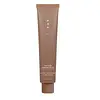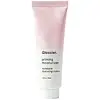What's inside
What's inside
 Key Ingredients
Key Ingredients

 Benefits
Benefits

 Concerns
Concerns

 Ingredients Side-by-side
Ingredients Side-by-side

Water
Skin ConditioningOctyldodecanol
EmollientCaprylic/Capric Triglyceride
MaskingIsopropyl Myristate
EmollientGlycerin
HumectantCetearyl Alcohol
EmollientButylene Glycol
HumectantDimethicone
EmollientPEG-100 Stearate
Cyclohexasiloxane
EmollientCyclopentasiloxane
EmollientSodium Polyacrylate
AbsorbentPhenoxyethanol
PreservativeBisabolol
MaskingTocopheryl Acetate
AntioxidantCetearyl Glucoside
EmulsifyingHydroxyacetophenone
AntioxidantAllantoin
Skin ConditioningEthylhexylglycerin
Skin ConditioningDisodium EDTA
Caprylyl Glycol
EmollientHydrolyzed Soy Protein
HumectantLactic Acid
BufferingRice Amino Acids
Skin ConditioningCitric Acid
BufferingProline
Skin ConditioningAcetyl Dipeptide-3 Aminohexanoate
Skin ConditioningDiaminopropionoyl Tripeptide-33
Skin ConditioningHydrolyzed Adansonia Digitata Seed Extract
Acetyl Hexapeptide-49
Skin ConditioningWater, Octyldodecanol, Caprylic/Capric Triglyceride, Isopropyl Myristate, Glycerin, Cetearyl Alcohol, Butylene Glycol, Dimethicone, PEG-100 Stearate, Cyclohexasiloxane, Cyclopentasiloxane, Sodium Polyacrylate, Phenoxyethanol, Bisabolol, Tocopheryl Acetate, Cetearyl Glucoside, Hydroxyacetophenone, Allantoin, Ethylhexylglycerin, Disodium EDTA, Caprylyl Glycol, Hydrolyzed Soy Protein, Lactic Acid, Rice Amino Acids, Citric Acid, Proline, Acetyl Dipeptide-3 Aminohexanoate, Diaminopropionoyl Tripeptide-33, Hydrolyzed Adansonia Digitata Seed Extract, Acetyl Hexapeptide-49
Water
Skin ConditioningCaprylic/Capric Triglyceride
MaskingPropanediol
SolventSqualane
EmollientBehenyl Alcohol
EmollientCetyl Alcohol
EmollientGlycerin
HumectantSorbitan Stearate
EmulsifyingPseudozyma Epicola/Camellia Japonica Seed Oil Ferment Extract Filtrate
Emulsion StabilisingSodium Hyaluronate Crosspolymer
HumectantAloe Barbadensis Leaf Juice
Skin ConditioningBuddleja Officinalis Flower Extract
UV FilterPoria Cocos Extract
Skin ConditioningPhragmites Communis Extract
Skin ConditioningTocopheryl Acetate
AntioxidantBetaine
HumectantSucrose Cocoate
EmulsifyingEthylhexylglycerin
Skin ConditioningHydroxyethyl Acrylate/Sodium Acryloyldimethyl Taurate Copolymer
Emulsion StabilisingMicrocrystalline Cellulose
AbsorbentCellulose Gum
Emulsion StabilisingPolysorbate 60
EmulsifyingSorbitan Isostearate
EmulsifyingTrisodium Ethylenediamine Disuccinate
Potassium Sorbate
PreservativeSodium Benzoate
MaskingPentylene Glycol
Skin ConditioningCitric Acid
BufferingWater, Caprylic/Capric Triglyceride, Propanediol, Squalane, Behenyl Alcohol, Cetyl Alcohol, Glycerin, Sorbitan Stearate, Pseudozyma Epicola/Camellia Japonica Seed Oil Ferment Extract Filtrate, Sodium Hyaluronate Crosspolymer, Aloe Barbadensis Leaf Juice, Buddleja Officinalis Flower Extract, Poria Cocos Extract, Phragmites Communis Extract, Tocopheryl Acetate, Betaine, Sucrose Cocoate, Ethylhexylglycerin, Hydroxyethyl Acrylate/Sodium Acryloyldimethyl Taurate Copolymer, Microcrystalline Cellulose, Cellulose Gum, Polysorbate 60, Sorbitan Isostearate, Trisodium Ethylenediamine Disuccinate, Potassium Sorbate, Sodium Benzoate, Pentylene Glycol, Citric Acid
 Reviews
Reviews

Ingredients Explained
These ingredients are found in both products.
Ingredients higher up in an ingredient list are typically present in a larger amount.
This ingredient is an emollient, solvent, and texture enhancer. It is considered a skin-softener by helping the skin prevent moisture loss.
It helps thicken a product's formula and makes it easier to spread by dissolving clumping compounds.
Caprylic Triglyceride is made by combining glycerin with coconut oil, forming a clear liquid.
While there is an assumption Caprylic Triglyceride can clog pores due to it being derived from coconut oil, there is no research supporting this.
Learn more about Caprylic/Capric TriglycerideCitric Acid is an alpha hydroxy acid (AHA) naturally found in citrus fruits like oranges, lemons, and limes.
Like other AHAs, citric acid can exfoliate skin by breaking down the bonds that hold dead skin cells together. This helps reveal smoother and brighter skin underneath.
However, this exfoliating effect only happens at high concentrations (20%) which can be hard to find in cosmetic products.
Due to this, citric acid is usually included in small amounts as a pH adjuster. This helps keep products slightly more acidic and compatible with skin's natural pH.
In skincare formulas, citric acid can:
While it can provide some skin benefits, research shows lactic acid and glycolic acid are generally more effective and less irritating exfoliants.
Most citric acid used in skincare today is made by fermenting sugars (usually from molasses). This synthetic version is identical to the natural citrus form but easier to stabilize and use in formulations.
Read more about some other popular AHA's here:
Learn more about Citric AcidEthylhexylglycerin (we can't pronounce this either) is commonly used as a preservative and skin softener. It is derived from glyceryl.
You might see Ethylhexylglycerin often paired with other preservatives such as phenoxyethanol. Ethylhexylglycerin has been found to increase the effectiveness of these other preservatives.
Glycerin is already naturally found in your skin. It helps moisturize and protect your skin.
A study from 2016 found glycerin to be more effective as a humectant than AHAs and hyaluronic acid.
As a humectant, it helps the skin stay hydrated by pulling moisture to your skin. The low molecular weight of glycerin allows it to pull moisture into the deeper layers of your skin.
Hydrated skin improves your skin barrier; Your skin barrier helps protect against irritants and bacteria.
Glycerin has also been found to have antimicrobial and antiviral properties. Due to these properties, glycerin is often used in wound and burn treatments.
In cosmetics, glycerin is usually derived from plants such as soybean or palm. However, it can also be sourced from animals, such as tallow or animal fat.
This ingredient is organic, colorless, odorless, and non-toxic.
Glycerin is the name for this ingredient in American English. British English uses Glycerol/Glycerine.
Learn more about GlycerinTocopheryl Acetate is AKA Vitamin E. It is an antioxidant and protects your skin from free radicals. Free radicals damage the skin by breaking down collagen.
One study found using Tocopheryl Acetate with Vitamin C decreased the number of sunburned cells.
Tocopheryl Acetate is commonly found in both skincare and dietary supplements.
Learn more about Tocopheryl AcetateWater. It's the most common cosmetic ingredient of all. You'll usually see it at the top of ingredient lists, meaning that it makes up the largest part of the product.
So why is it so popular? Water most often acts as a solvent - this means that it helps dissolve other ingredients into the formulation.
You'll also recognize water as that liquid we all need to stay alive. If you see this, drink a glass of water. Stay hydrated!
Learn more about Water